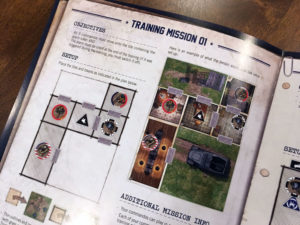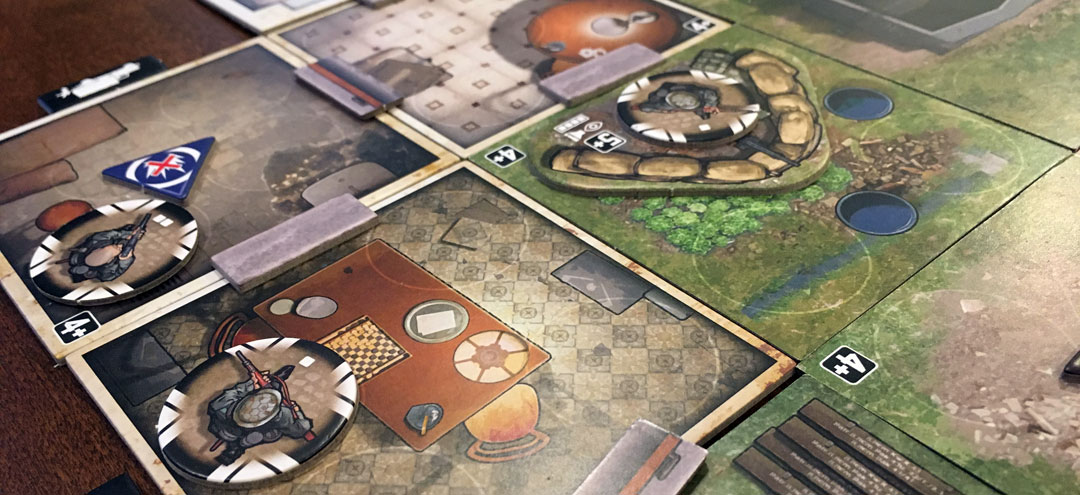 Superhero movies are ubiquitous today. You can’t go six to eight months without seeing one or watching a trailer for the next. If you travel back in time to the late 1950s through the 1960s and 70s, the World War II commando replaces the superhero. Wouldn’t it be great if someone made a board game that covers that genre? Triton Noir did and they’re hoping V-Commandos makes gamers feel just like they’re acting out Dirty Inglorious Force 10 Guns of the Dozen Eagles of Navarone.
Superhero movies are ubiquitous today. You can’t go six to eight months without seeing one or watching a trailer for the next. If you travel back in time to the late 1950s through the 1960s and 70s, the World War II commando replaces the superhero. Wouldn’t it be great if someone made a board game that covers that genre? Triton Noir did and they’re hoping V-Commandos makes gamers feel just like they’re acting out Dirty Inglorious Force 10 Guns of the Dozen Eagles of Navarone.
V-Commandos is a tactical stealth/combat cooperative game for 1-4 players. A single mission takes about 30 minutes to play and a multi-mission operation can go up to 2 1/2 hours depending on how argumentative the commandos are.
Game Overview:
Players in V-Commandos are WWII soldiers taking on missions of various types including assassination, rescue, stealing plans and overall sabotage. Even if certain commandos are killed on the mission, the team wins (usually) or loses as a whole.
Game Components:

The components for V-Commandos are functional, but a bit spartan. There’s no flashy plastic. All components are cardboard (tiles and tokens) or cards. The tokens represent any object or person to be found in a mission and the tiles represent all the structures, rooms and areas of the mission. Because the tiles do not interlock (probably an aesthetic choice) and the tokens are frequently manipulated, the tiles often get out of alignment. It’s annoying, but not really game breaking to constantly adjust the position of a room on the table surface.
Despite this, the art and visual design for V-Commandos is very well done. The lack of miniatures makes sense once the nature of the double-sided unit tokens are seen in action. The different sides of many tokens and tiles share a dual purpose, making for an easy to use experience overall. For example, one side of a commando is the stealthy side, the other if they are visible. The icons take a small bit of explanation as well to aid this.
The main object of frustration and appreciation in the game is the rulebook. There is A LOT to digest in this game. Those familiar with tactical miniatures combat games will find some things familiar, but many of the stealth rules and how they work with tiles will seem, at first, counterintuitive or non-realistic. There is a lot of referencing the manual at times for reminders on how things work with equipment or other tokens. The included training missions do a great job helping players to understand the basics of the game, but it can also trip players up who think they know other games well enough to just start playing.
How to Play:

Any session of V-Commandos focuses on first selecting the mission. The mission setups are laid out on cards and different missions have a variety of difficulty and challenging objectives. For more of a campaign feel, players can take on an “Operation” that spans multiple missions. During setup, players assemble the room and outdoor tiles then place the starting configuration of tokens.
Players also select the team roles they wish to play. An Officer, Sniper, Scout, Saboteur, and Medic are included, each with two varieties. The roles are of varied use from mission to mission, and the variant sides of the role cards give just enough choice.
Once setup is complete, play proceeds round by round through four phases:
- Event Phase – A card is drawn from an event deck and the indicated change is implemented. These could be a simple one-time effect or it could represent a change in mechanisms for the round.
- Commando Phase – The main actions of the players are conducted in this phase. Each commando receives three action points to use with different actions.
For example, there is a distinction between moving silently and making noise with any given action that may cost extra action points. The status as to when a commando is stealthy or not comes up repeatedly. This affects other game events such as the enemy intruder alarm and numbers of enemy reinforcements. Commandos also have to take into consideration how silent their weapons are and what kind of attacks they should make to maintain stealth. - Enemy Phase – In order, enemy (German) units will be added to the map, move, and shoot any visible commandos. If commandos are visible, enemy units move towards the commando. If none of the commandos are visible, the enemy units move randomly as determined by the event card. If an enemy unit manages to shoot a commando, the commando receives -1 action for all subsequent rounds.
- End of Turn Phase – This phase is primarily used to determine if the commandos have completed the mission successfully.

Game Experience:
A covert raid of an enemy outpost, whatever the military genre, is about maintaining invisibility, taking evaluation of self and enemy observation into account at every step. It’s not about bringing the biggest weapon and mowing dudes down. It’s a task of complex thought and precision. This puzzly element is at the heart of V-Commandos and, notwithstanding the effects of some randomness, it gets it just right.
Every mission is about choosing the right time to accomplish an action or to wait for a more opportune time. When players make decisions regarding their actions, they MUST do it as a team and in concert. This mental thread runs through everything in the game, and it’s what makes success really feel like an actual accomplishment. Similar to Pandemic, this cooperative spirit really shines and sacrifice plays by team members can really drive the mechanisms and theme as well.

But also like Pandemic, there is a risk when playing with certain types of players. V-Commandos is really susceptible to alpha gamer team management. One main way to address this in game is to make the alpha gamer take on the Officer role. They can then bark orders at everybody, and maybe they’ll be followed.
Otherwise, the presence of this gamer can really detract from the team spirit. One saving grace is that since many actions might have a random outcome based on stealth or shooting dice rolls, the alpha gamer cannot always count on being right, just that the odds predict a certain outcome.
This is where some disappointment can come in. A perfectly considered plan that goes wrong because of the randomness of a roll can really dampen the mood and cause a mission to fail quickly. Even though the game does not provide it, for players who want a little more forgiveness, it’s easy to implement a reroll system. However, if players want to be hardcore, many missions and operations also provide higher difficulty settings. This variable difficulty is appreciated and necessary.

The main thing to hamper enjoying V-Commandos is the learning curve. Understanding how stealth and the enemy phase works takes some focus and the training missions are indispensable. Each role also has some specific powerful effects and making the best use of these at the right moment is an important skill to have.
The other negative to mention is that there is a real dearth of environmental effects in the game besides the event cards. It’s unfortunate that these are random instead of the terrain dictating these. The events on many of the cards can sometimes feel very arbitrary. Once again, it’s easy to take out cards that may be too punishing, but on the whole, there is little in the way of terrain design. An expansion with new landscapes and missions to take advantage of new objective tokens would be extremely welcome.
Final Thoughts:
V-Commandos, despite it’s look, is a strong puzzle/risk-taking game. It’s hard to say if tactical gamers will like it because the overall feel is VERY different. Where a fantasy dungeon crawl might ask for brute force, V-Commandos asks for finesse and difficult decisions. This, more than other games, spurs arguments over which tactics to take and so alpha gamers will be really unwelcome. Despite this, it’s an amazingly tense and fun experience that is just as exciting solo as with friends.
If you’d like to get a copy of V-Commandos, you can pick it up for about $85.
Final Score: 4 Stars – Complex rules and amazingly tense play are prevalent, despite mundane components. Alpha gamers should just play the included British “Officer” character and be forced to do the accent.
 Hits:
Hits:
• Complex, deep decisions
• Theme and story come alive
• High variety in play style
• Rulebook and training material
Misses:
• Learning curve
• Map tile variety and design






















